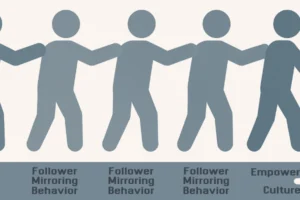Three Vital Components to Leadership
There are three highly critical components of outstanding leadership. While they may appear extremely simple at first glance, they can also be highly complex at the same time. I contend that these elements may take some practice to master and that the time you invest is more than worth it. These three components are thought, decision-making, and communication.
“Thought” may seem simple enough, but only if you do it wrong. There is a process if you want to make the right decisions more often. Strategic, critical, systems, tactical, creative, and reflective thinking are all similar because they require deep thought. Still, they are very different modes as far as the act of thinking goes. If you boil it down, you could almost say that the six different types of thinking are just a road map of sound decision-making – meaning that if you follow the process and practice it often, your decisions will improve. It doesn’t take a genius to recognize that proper thought processes will make better decisions.
Strategic Thinking could be defined as a mental process applied by an individual in the context of achieving success. Perhaps the best way to explain this would be to say it is the broad “End Game” way of thinking. So, where Strategic Thinking may define the path, Critical Thinking would be the reflective judgment concerning what to do. Systems Thinking is the process of understanding how things influence one another. This could be the “cause and effect” of the thinking processes. Tactical Thought would analyze specific resources available or needed to achieve each step in the broader “End Game.” Creative Thought is the ability to create. In this context, it would be the ability to develop solutions or ideas to resolve the “End Game.” It could also be simply “thinking outside of the box.” Reflective Thought would be utilized when the “End Game” has been achieved and you analyze what had been done and how you did it to improve or fine-tune future decisions.
Each step should be considered a piece of a much bigger leadership process. This process is essential to a leader for numerous reasons. Aside from the obvious, I would imagine that consciously addressing each type of thought when making a decision would aid significantly in the number of times a correct decision was made. Rather than just making what would end up being a rash or “gut” decision, a deliberate effort to address each type of thought, perhaps aided by my “Three Rule Method,” would undoubtedly generate more solid ideas and direction.
This benefits you because solid ideas and sound decisions will ease the followers’ minds and reassure them that they are following the right person. This is because the decisions and direction will be quality decisions and directions more often than not. This will establish confidence in your followers, but also in yourself. This benefits you even more because followers will be better focused on the tasks rather than doubting you.
Critical Thought is where many “struggle” regarding the process. This is because some feel that they do not have the “full-proof” answer, even when having addressed the other steps and even when applying the “Three Rule Method” (which, for clarity, is comprised of logic, cause and effect, and Occam’s Razor). They doubt themselves. This doubt is based on fear. So if this is you, take heart. Here is one of the best-kept secrets of leadership – there is no such thing as a “full-proof” answer. If there were, famous Generals and powerful leaders would have been a thing of the past long ago. If you follow the process, your decisions will be the best based on the information at hand.
Still, while a leader’s decisions and direction using this method tend to be at least “more accurate” than others, the confidence to support or communicate such decisions can sometimes be lacking. As stated earlier, better decisions can provide better results. But better results can only be achieved if the decisions are adequately communicated to those carrying out the task. This can be an issue for those with interpersonal problems and those who feel they have made too many mistakes in the past. As a result, trying to overcome those mistakes to become more confident in the future becomes difficult. The key here is to step out on the ledge and make the decisions anyway. It would be best to build confidence, and getting it right will help. And you WILL have it right, by the way, because you followed the thought process.
I don’t want to beat this horse. Still, I understand that many of the dents in our proverbial armor come directly from the “mental abuse” sustained in previous relationships or experiences and how horribly some of us have or continue to navigate these circumstances. This sometimes leads to a communication problem in general. But as a leader, you still need to communicate your decisions or directions. That’s what leadership is all about. Your interpersonal or confidence issues do not negate what is required of you. What good is a decision or direction if you cannot successfully communicate them? If you cannot find it in yourself to communicate, then it could be a deal-breaker for you because your leadership ability will be suspect. It might be best for you and your followers to consider stepping down. But before you do that, I want you to consider the following…
You are not alone. But we need to evaluate and address our interpersonal effectiveness in its broadest terms. Many great leaders are scared in crowds. Some continually doubt themselves. The point is that they keep working on trying to overcome their issues. This may require continual refinement and reflection because it may include issues within our friendships, professional encounters, educational endeavors, and relationships within our family. This refinement and reflection may be as simple as “letting go” for some, or others, simply finishing something you had once set out to do. Others may need to talk their problems out, and still, some need to get a few solid decisions under their belt. It is truly different for everyone. Regardless, understand that there is no such thing as perfection. Even if things are getting better all the time, we should still recognize that we are emotional beings and subject to the repercussions it may bring. There is something that can help, though.
For the life of me, I cannot recall where I picked this next tool up, so a citation will have to go out to the Psychology community at large. Anyway, it is called “Dear Man Give Fast.” It is an acronym that suggests you describe, express, assert, reinforce, be mindful, appear confident, negotiate, be gentle, be interested, validate yourself and others, be easy-going, be fair to yourself and others, do not apologize, stick to your values, and be truthful. Following this little guide will help in your leadership and communication substantially. This is one of the many tools I successfully use to help navigate my road map to interpersonal relationships, so hopefully, it helps you.
Remember the point of all this. You must understand that the three most critical components of great leadership are sound thinking, actually deciding on something and excellent communication regarding what you have decided. You must have these to be a successful leader. More often than not, while simple, these are easier said than done, especially when the “sound thinking” part hasn’t been given much thought in the first place or when communicating that decision with anyone is a problem for any reason. These elements may take some practice. Practice the three and complete the process to the fullest; even if you have interpersonal issues, it will eventually become a habit.
Did you enjoy this article? You might also like “Defining Your Leadership Traits and Theories.”
Resources:
de Janasz, S. C., Dowd, K. O., & Schneider, B. Z. (2012).Interpersonal skills in organizations. (4th ed.). Columbus, OH: McGraw-Hill.
Griffith, D. B., & Goodwin, C. (2013). Conflict survival kit. Tools for resolving conflict at work. (2nd ed.). Upper Saddle River, NJ: Pearson




